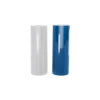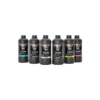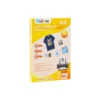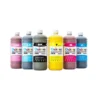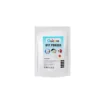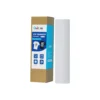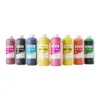UV AB films can be applied as decals to hard surfaces like glass, metal, wood, and acrylic. Because the process requires both films to work in tandem, it’s important to understand how they function.
In this article, we’ll walk you through everything you need to know about this film, including how to use it and some common questions.
What Is UV AB Film?
UV AB Film is a two-part film system used in UV DTF (Direct to Film) printing, which allows UV-printed designs to be transferred to a variety of hard surfaces without the need for heat pressing.
- A Film (Printing Film): This is the top layer designed to receive UV ink from the printer. Its surface has a special coating that absorbs the UV ink, enabling the printing process.
- B Film (Transfer Film): This is the bottom layer, a transparent adhesive film that transfers the printed design from A Film to the object. It carries the final sticker onto the desired surface.
- Here you can think of B-film as providing adhesion to the ink on A-film. After they are laminated and synthesized, the A-films are usually scrapped.
These two films must work together, and their lamination process is what activates the transfer ability. This type of film is also known in the market as UV DTF sticker. That’s because, after peeling off the A film, it can be directly applied to most rigid materials.
See also: Quick Start Guide: UV DTF AB Films.



How to Use UV AB Film: Step-by-Step
There are way too many ways on the web about how to use UV AB Film. I will only give some brief descriptions here, if you wish to see a more detailed description you can refer to this article.
1.Prepare Your Design
- Use RIP software to prepare your artwork.
- Ensure the resolution is high and colors are correct.
- Design should include white ink base, CMYK color, and clear varnish layers.
2.Print on the A Film
- Load the A Film (shiny side up) into your UV DTF printer.
- Print in the order: white layer → color layer → clear varnish.
- Use UV-curable ink, which will be instantly hardened during printing.
Feel free to use alternative printing methods if they better showcase the design, even if it deviates from my instructions.

3.Laminate B Film
- Place the B Film (sticky side down) on top of the printed A Film.
- Use a laminator to bond the films. By the way, you might need to adjust the temperature.
- Lamination ensures a smooth transfer surface and removes air bubbles.
In reality, many UV printers today come with built-in laminating modules, eliminating the need for manual lamination.

4.Apply to Surface
- Trim the laminated sticker.
- Peel off the A Film—the design will now stay on the B Film.
- Place the B Film on your object (design side down).
- Press with a squeegee to eliminate air gaps.
- Slowly peel away the B Film, leaving the design behind.
If you just want to understand the way to use B film, see this article: How To Use A UV DTF Type B Without Printer.
Common Issues When Using UV AB Film
Film Warping or Wrinkling During Printing
- Cause: Misalignment or uneven film tension.
- Solution: Align film properly; use a flat vacuum bed or secure with masking tape.
Design Not Sticking Well to Surface
- Cause: Poor surface prep, low-quality ink, or expired film.
- Solution: Clean the surface; use compatible UV ink and well-stored film.

If you have encountered a similar problem as in the picture, you can refer to this article to find a solution: How To Solve Insufficient Adhesion Of UV DTF Inks?
Air Bubbles or Uneven Adhesion
- Cause: Dust during lamination or improper pressure during transfer.
- Solution: Use a clean laminator and press with consistent pressure when applying the sticker.

See also: How To Solve The Blistering Of UV DTF Inks Printing?
A Film Difficult to Peel
- Cause: Insufficient lamination or incorrect temperature.
- Solution: Re-laminate at correct temperature and allow a few seconds to cool before peeling.
Difference Between UV AB Film and DTF Film
While both are used in “direct-to-film” workflows, UV AB Film and DTF Film are entirely different in materials, applications, and processing:
| Feature | UV AB Film | DTF Film |
|---|---|---|
| Ink Type | UV-curable ink | Water-based pigment ink |
| Surface Compatibility | Hard materials (glass, metal, plastic, etc.) | Fabric (cotton, polyester, blends) |
| Film Layers | Dual layer: A Film + B Film | Single film with coating |
| Transfer Method | Cold peel, no heat press needed | Heat press with hot-melt powder |
| Lamination Needed | Yes (to merge A and B films) | No (used directly after curing powder) |
| Use Case | Tumblers, signs, mugs, keychains | Apparel, bags, fabric-based accessories |
Key takeaway: UV AB Film is for rigid surface decoration, while DTF Film is for textile printing. Mixing them can cause printing failure or equipment damage.
For more information on the differences between these two films, see: UV DTF AB film vs. DTF film.

FAQ
Q1: Can I use UV AB Film on fabric? No. UV AB Film is not designed for flexible surfaces like textiles.
Q2: Why is my print not sticking to the B Film? This may happen if the lamination wasn’t hot enough or if the UV ink didn’t fully cure.
Q3: What materials work best with UV AB Film transfers? Smooth, clean, hard surfaces like acrylic, wood, glass, stainless steel, and ceramics.

